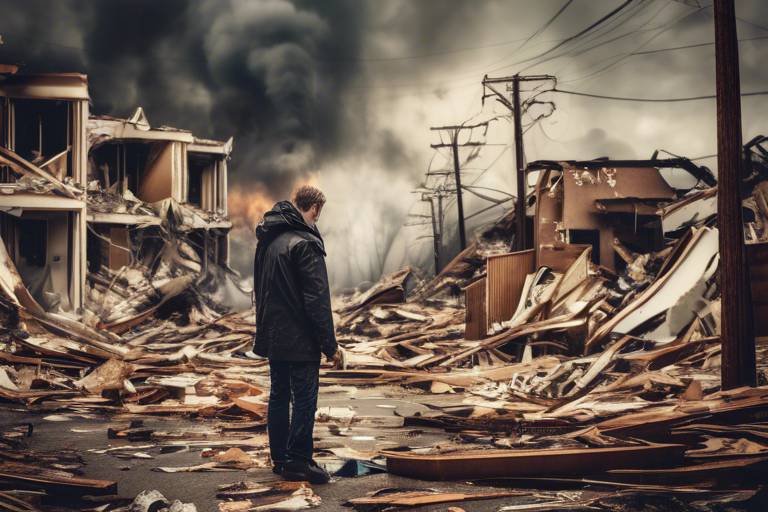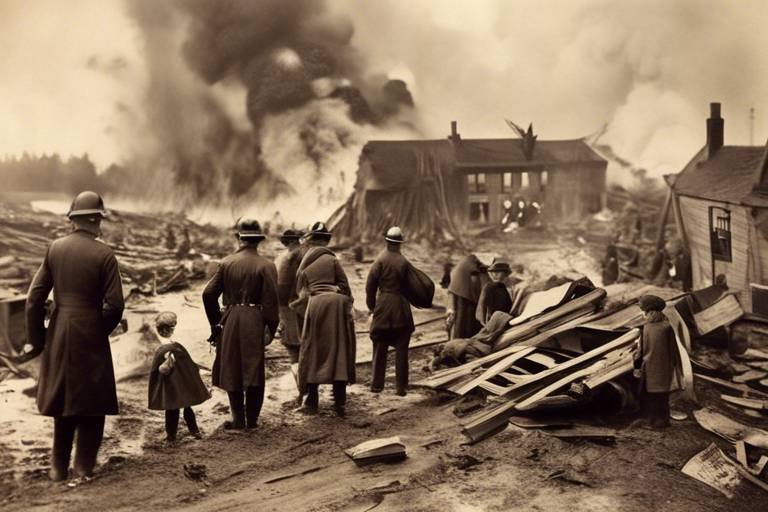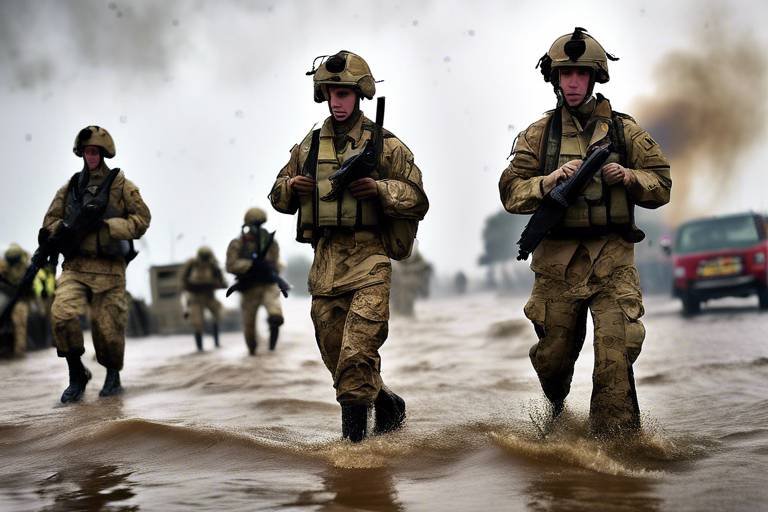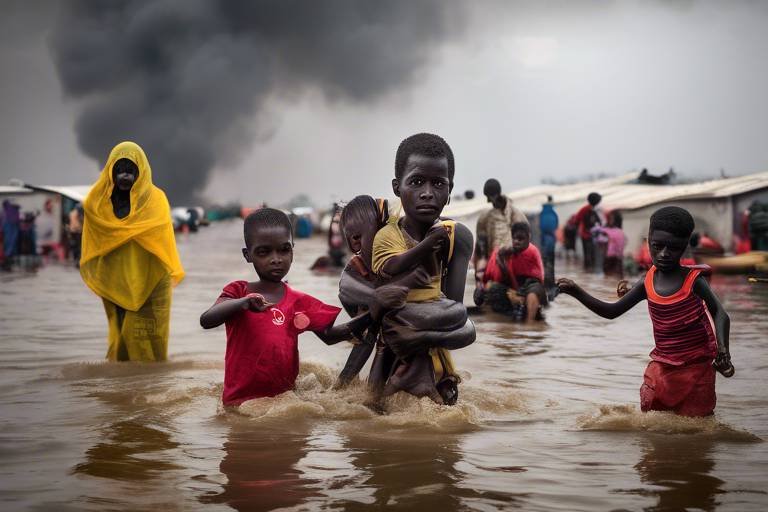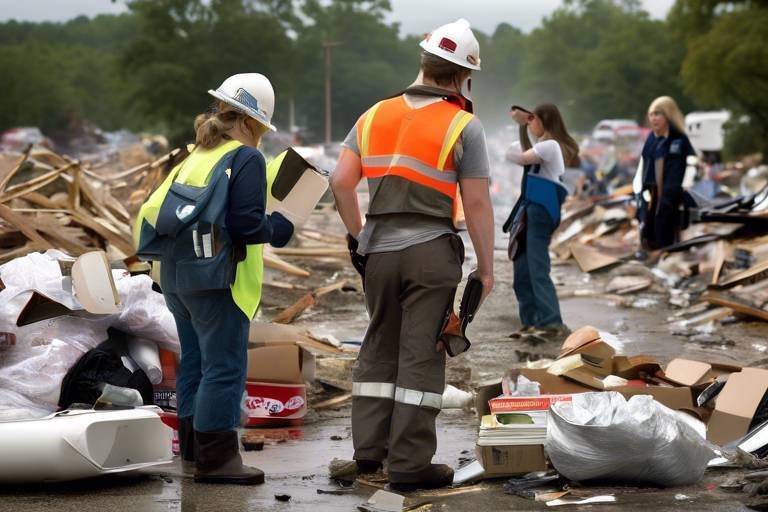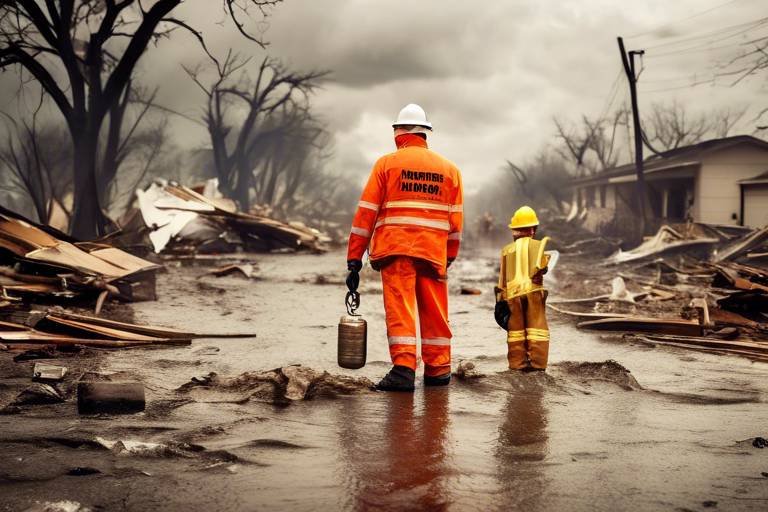How to Volunteer in Disaster-Stricken Areas?
Volunteering in disaster-stricken areas is a noble and impactful way to give back to communities in dire need. It’s not just about lending a helping hand; it’s about understanding the nuances of disaster relief and the profound effects it can have on those affected. Imagine being the beacon of hope in a community that has just faced the unimaginable—your presence could mean the world to someone who has lost everything. But before you pack your bags and head out, there are essential steps and considerations to keep in mind that will not only prepare you for the journey ahead but also amplify the effectiveness of your contributions.
Understanding the nature of disaster relief is crucial for any volunteer. It’s not merely about providing immediate aid; it’s about grasping the challenges faced by affected communities and the significance of organized assistance. Disasters can leave communities in a state of chaos, and without structured support, recovery can be slow and painful. When you volunteer, you’re not just offering your time; you’re becoming a part of a larger effort aimed at rebuilding lives and restoring hope. The impact of your work can resonate far beyond the immediate response, fostering resilience and strength within the community.
Before diving into volunteer work, it’s essential to research available opportunities. This involves identifying organizations that resonate with your skills and interests. Are you a medical professional? Perhaps you could join a health-focused organization. Do you have experience in logistics? Many disaster relief organizations need help with supply chain management. Understanding the specific needs of these organizations can significantly enhance the effectiveness of your contributions. Just think about it—by aligning your skills with the right opportunity, you’re not just volunteering; you’re maximizing your impact.
When considering volunteering, you’ll face the decision of whether to work locally or internationally. Each option comes with its unique set of challenges and rewards. Local volunteering allows you to make an immediate impact within your community, helping those around you and witnessing the direct effects of your efforts. On the other hand, international volunteering can provide a broader perspective on global issues, yet it often requires more resources and planning. You’ll need to evaluate your personal situation—your time, finances, and the specific needs of the disaster-stricken areas you’re considering.
Local volunteering can be incredibly rewarding. You get to see the fruits of your labor firsthand, fostering relationships with those you assist. The connections you build can lead to a deeper understanding of the community’s needs and strengths. Plus, there’s something profoundly satisfying about helping your neighbors in their time of need. You become a part of their recovery story, and that’s a privilege that few experiences can match.
While international volunteering can be a life-changing experience, it’s not without its challenges. Logistical hurdles such as travel arrangements, cultural differences, and language barriers can complicate your efforts. It’s essential to be adaptable and culturally sensitive, as you’ll be entering communities with their own customs and ways of life. This adaptability is crucial for effective support and can significantly enhance your experience as a volunteer.
Proper preparation is key to successful volunteer work. This includes acquiring necessary skills, gathering supplies, and understanding the physical and emotional demands of disaster response. You might consider taking first aid courses or learning about trauma-informed care to better equip yourself for the challenges ahead. Remember, being prepared isn’t just about having the right supplies; it’s also about having the right mindset. The emotional toll of working in disaster-stricken areas can be significant, and being mentally prepared will help you navigate those challenges more effectively.
Safety should always be your top priority when volunteering in disaster areas. Understanding potential risks, following established guidelines, and prioritizing your well-being can help ensure a safe and productive experience. It’s easy to get caught up in the desire to help, but neglecting your safety can lead to more harm than good.
Taking health precautions is crucial for volunteers. This may involve getting vaccinations or undergoing first aid training to protect yourself and those you’ll be working with. Disaster areas can pose various health risks, from infectious diseases to injuries from debris. By being proactive about your health, you not only safeguard yourself but also enhance the overall safety of the community you’re serving.
Familiarizing yourself with emergency protocols is vital. Knowing how to respond to unforeseen situations can enhance safety for both you and the communities you serve. Whether it’s understanding evacuation routes or knowing whom to contact in case of an emergency, being prepared can make a significant difference in your volunteer experience.
Volunteering in disaster-stricken areas can lead to lasting change. To truly make a difference, it’s essential to engage with communities, provide sustainable support, and follow up on recovery efforts. Your role doesn’t end when the immediate crisis is over; staying connected and involved can help ensure that the positive effects of your work continue long after you’ve left. Remember, every small action contributes to a larger narrative of recovery and resilience.
Q: How can I find volunteer opportunities in disaster-stricken areas?
A: Start by researching reputable organizations that focus on disaster relief. Websites like VolunteerMatch or local community centers can provide valuable leads.
Q: Do I need special skills to volunteer?
A: While specific skills can be beneficial, many organizations welcome volunteers with diverse backgrounds. It’s essential to assess what you can offer and find a role that matches your abilities.
Q: What should I pack for volunteering?
A: Essentials include personal identification, necessary medications, appropriate clothing, and any specific supplies requested by the organization you’re volunteering with.
Q: How can I stay safe while volunteering?
A: Prioritize your safety by following guidelines, staying informed about the area, and being aware of your surroundings. Consider taking a first aid course before your trip.

Understanding Disaster Relief
When we think about disaster relief, it's essential to realize that it's more than just a quick response to an emergency; it’s a complex web of support, coordination, and compassion aimed at helping communities rebuild and recover. Imagine a town struck by an earthquake, where homes are reduced to rubble, and families are left without basic necessities. This is where the true essence of disaster relief comes into play. It involves not only immediate assistance but also long-term recovery efforts that can take months or even years.
At its core, disaster relief is about understanding the needs of those affected. Volunteers step into a world where chaos reigns, and their presence can make a significant difference. However, the challenges faced by these communities are vast. From logistical hurdles like distributing food and water to emotional struggles such as dealing with loss, the scope of disaster relief is broad. This is why organized assistance is crucial; it ensures that help is delivered effectively and efficiently.
Moreover, disaster relief is not a one-size-fits-all approach. Each disaster comes with its unique set of challenges. For instance:
- Natural Disasters: Events like hurricanes or floods often require immediate evacuation and shelter for displaced individuals.
- Human-Made Disasters: Situations such as industrial accidents or terrorist attacks may necessitate specialized medical support and psychological counseling.
Understanding the nature of these challenges helps volunteers grasp the importance of their role. It’s not just about showing up; it’s about being prepared, informed, and ready to adapt to the needs of the community. For example, volunteers might need to coordinate with local authorities to ensure that their efforts align with ongoing recovery plans. This level of organization ensures that all hands on deck are working towards a common goal.
In addition, the emotional toll on disaster-stricken communities cannot be overstated. Volunteers often find themselves in situations where they must provide not only physical assistance but also emotional support. This aspect of disaster relief is crucial, as it helps foster resilience among affected individuals. Being there to listen, to comfort, and to assist in the healing process can be just as important as providing food and shelter.
Ultimately, understanding disaster relief is about recognizing the profound impact that organized assistance can have on a community in crisis. It’s a call to action for those willing to lend a hand, reminding us that, together, we can help rebuild lives and restore hope. This understanding sets the foundation for effective volunteering, ensuring that efforts are not just well-intentioned but also well-executed.

Researching Opportunities
When it comes to volunteering in disaster-stricken areas, the first step is that resonate with your skills and passions. This process is not just about finding a place to lend a hand; it’s about aligning your efforts with the specific needs of affected communities. Think of it like a puzzle—each piece, or volunteer, has a unique shape and purpose that can fit into the larger picture of recovery. By understanding the various organizations and their missions, you can ensure that your contributions are both effective and meaningful.
Start by identifying reputable organizations that are actively involved in disaster relief. This can include local charities, national nonprofits, or even international agencies. Websites like VolunteerMatch and Idealist can be great resources for finding volunteer opportunities that suit your interests. Always take the time to read reviews and testimonials from other volunteers. This will give you insight into the organization’s operations and the impact of their work.
Additionally, consider the skills you bring to the table. Are you a medical professional, a logistics expert, or perhaps a skilled communicator? Different roles require different expertise, and knowing where you fit best can enhance your volunteer experience. For instance, medical volunteers may be needed in triage settings, while those with logistical skills can help coordinate supplies and resources. Here’s a quick breakdown of common roles:
| Role | Description | Skills Needed |
|---|---|---|
| Medical Volunteer | Provides healthcare services and support | Medical training, first aid |
| Logistics Coordinator | Manages supply distribution and resource allocation | Organizational skills, problem-solving |
| Community Outreach | Engages with the local community to assess needs | Communication, empathy |
Once you’ve identified potential organizations and roles, reach out to them. Don’t hesitate to ask questions about their current needs, the types of volunteers they’re looking for, and how you can best contribute. This proactive approach not only shows your commitment but also helps you gauge whether the organization aligns with your values and goals. Remember, volunteering is a two-way street; it’s about making a connection and ensuring that your efforts are truly beneficial.
Lastly, keep in mind the importance of flexibility. Disaster situations are often fluid, and needs can change rapidly. Being adaptable will allow you to make the most of your volunteer experience. Whether you’re helping with immediate relief efforts or engaging in long-term recovery projects, your willingness to adjust will amplify your impact. So, dive into your research, connect with organizations, and prepare to make a difference!
- How do I find volunteer opportunities in disaster areas? You can find opportunities through websites like VolunteerMatch and Idealist, as well as by reaching out to local charities and national organizations involved in disaster relief.
- What skills are most needed for disaster volunteering? Skills in healthcare, logistics, community engagement, and communication are often in high demand, but every skill set can contribute in some way.
- Is it safe to volunteer in disaster-stricken areas? Safety is a priority, and it’s important to follow guidelines and protocols set by the organization you’re volunteering with.
- Can I volunteer internationally? Yes, many organizations offer international volunteering opportunities, but be prepared for logistical challenges such as travel and cultural differences.

Local vs. International Volunteering
When it comes to volunteering in disaster-stricken areas, one of the first decisions you'll need to make is whether to volunteer locally or internationally. This choice can significantly affect your experience, the impact you have, and even your personal growth. Local volunteering often allows you to stay close to home, where you can quickly mobilize and respond to immediate needs. You can easily connect with your community, and your efforts can be seen and felt right away. Imagine the satisfaction of helping a neighbor rebuild their home or distributing supplies to families down the street. It's like being part of a close-knit family, where every little contribution makes a big difference.
On the flip side, international volunteering presents a whole new set of challenges and rewards. While the experience can be incredibly enriching—immersing yourself in a new culture, meeting new people, and making a difference in a completely different environment—it also comes with logistical hurdles. Think of it as an adventure where you step outside your comfort zone. You might need to navigate language barriers, cultural differences, and even travel restrictions. The thrill of helping communities in another country can be exhilarating, but it requires adaptability and a willingness to learn.
To help you weigh your options, consider the following factors:
- Time Commitment: Local volunteering may require less time away from your regular life, while international opportunities often need a longer commitment.
- Skill Alignment: Some organizations may specifically seek volunteers with particular skills, which can influence your choice.
- Personal Resources: Consider the financial and physical resources you have at your disposal for travel and accommodation.
Ultimately, the decision boils down to your personal circumstances and what you hope to achieve through your volunteer work. Whether you choose to stay local or venture abroad, the most important thing is to approach your volunteer efforts with an open heart and a willingness to help. After all, every bit of support counts, and your contributions—whether near or far—can lead to meaningful change.

Benefits of Local Volunteering
When it comes to making a difference, local volunteering stands out as a powerful way to contribute to your community. Imagine being able to see the immediate impact of your efforts right in your own backyard! Local volunteering allows you to connect with your neighbors, understand their needs, and witness firsthand the change you help create. This direct involvement not only fosters a sense of community but also builds lasting relationships with those you assist.
One of the most significant advantages of volunteering locally is the immediacy of impact. When you volunteer in your own community, you can see the results of your work almost instantly. Whether it’s helping to rebuild homes, distributing food, or providing emotional support, the effects of your contributions are visible and tangible. This can be incredibly rewarding and motivating, as you can directly relate your efforts to the positive changes in your community.
Moreover, local volunteering often requires less logistical planning compared to international opportunities. You don’t have to worry about travel expenses, visas, or cultural barriers. Instead, you can focus your energy on what truly matters—helping those in need. Being familiar with the local context also allows you to communicate more effectively and engage with community members on a deeper level. You already understand the local culture, customs, and challenges, which can significantly enhance your effectiveness as a volunteer.
Another noteworthy benefit is the personal growth that comes from local volunteering. Engaging with individuals from diverse backgrounds can broaden your perspective and deepen your empathy. You might find yourself learning new skills, such as crisis management or conflict resolution, that will not only aid you in your volunteer work but also benefit you in your personal and professional life. Plus, the connections you make can lead to new friendships and networking opportunities, enriching your social life.
Local volunteering also promotes community resilience. When people come together to support one another, it strengthens the social fabric of the community. You become part of a larger movement that encourages collaboration and mutual aid, creating a culture of support that can withstand future challenges. In times of crisis, having a network of committed volunteers can make all the difference in how quickly and effectively a community can recover.
In summary, the benefits of local volunteering are profound. From creating immediate change to fostering personal growth and community resilience, the rewards are plentiful. So, if you’re considering how to make a difference, think about the local opportunities available to you. You might just find that the most impactful contributions happen right where you live!
- What types of local volunteering opportunities are available? Local organizations often need volunteers for various tasks, including disaster relief, food distribution, tutoring, and community clean-ups.
- How can I find local volunteering opportunities? You can search online through platforms like VolunteerMatch or local community boards, or contact local nonprofits directly to inquire about their needs.
- Do I need special skills to volunteer locally? While some roles may require specific skills, many opportunities welcome volunteers of all backgrounds and experiences. Your willingness to help is often the most important factor!
- What should I expect when volunteering in my community? Expect to meet new people, face unique challenges, and gain a sense of fulfillment from making a difference in your community.

Challenges of International Volunteering
Volunteering internationally can be an incredibly rewarding experience, but it doesn't come without its set of challenges. Imagine stepping into a completely different world, where the culture, language, and even the climate can be vastly different from what you're used to. This can be both exhilarating and daunting. One of the primary challenges is navigating logistical issues. From securing travel arrangements to understanding visa requirements, these factors can complicate your plans and require extensive research and preparation.
Another significant hurdle is the cultural differences that you will encounter. Each country has its own customs, traditions, and social norms, which can affect how you interact with local communities. For instance, what might be considered polite in your home country could be perceived differently elsewhere. This necessitates a level of cultural sensitivity and adaptability, as you must learn to communicate and connect with people in a way that respects their values and beliefs.
Language barriers can also pose a challenge. While many organizations may provide basic language training, being fluent in the local language can greatly enhance your ability to engage with the community. Not being able to communicate effectively can lead to misunderstandings and may hinder your ability to provide the help that is needed. Therefore, it is often beneficial to invest time in learning some key phrases or even the basics of the local language before you embark on your journey.
Additionally, international volunteering often requires a significant time commitment. Unlike local volunteering, where you can contribute a few hours a week, international projects may require you to dedicate several weeks or even months. This can be challenging for those with jobs, families, or other obligations. It's essential to assess your own availability and ensure that you can commit fully to the project you choose.
Furthermore, the emotional toll of witnessing the aftermath of disasters in foreign countries can be profound. Volunteers may encounter heartbreaking situations that can lead to feelings of helplessness or frustration. It’s crucial to prepare yourself mentally and emotionally for the challenges you might face. Engaging in self-care and seeking support from fellow volunteers can help you cope with the emotional demands of this work.
In summary, while international volunteering presents unique challenges such as logistical issues, cultural differences, language barriers, time commitments, and emotional strains, it also offers opportunities for personal growth and meaningful contributions. The key is to approach these challenges with an open mind and a willingness to adapt, ensuring that your volunteer experience is both impactful and fulfilling.
- What should I consider before volunteering internationally? Before you volunteer internationally, consider your skills, the time you can commit, and the specific needs of the communities you wish to serve.
- Do I need to know the local language? While it's not always necessary, knowing some key phrases can greatly enhance your ability to connect with the community.
- How can I prepare for cultural differences? Research the culture of the country you plan to volunteer in to better understand their customs and norms.
- What are some safety precautions I should take? Always stay informed about the local situation, follow the guidance of your organization, and prioritize your well-being.

Preparing for Volunteer Work
When it comes to volunteering in disaster-stricken areas, preparation is key. Think of it like packing for a trip; you wouldn’t head out without ensuring you have everything you need, right? The same applies here. First and foremost, it’s crucial to acquire the necessary skills that will make you an effective volunteer. This might include training in first aid, crisis management, or even specific skills like construction or logistics. Many organizations offer training sessions, so be sure to take advantage of these opportunities.
In addition to skills, gathering essential supplies is vital. Picture yourself in a chaotic environment where resources are scarce; having the right tools can make all the difference. Here’s a quick checklist of items you might consider bringing:
- First Aid Kit: Always be prepared for minor injuries.
- Personal Protective Equipment: Depending on the environment, this may include gloves, masks, and safety goggles.
- Basic Supplies: Think food, water, and hygiene items, as these may not be readily available.
- Comfort Items: A sleeping bag, portable charger, and personal hygiene products can make your stay more comfortable.
Moreover, understanding the physical and emotional demands of disaster response is crucial. Volunteering in such environments can be incredibly rewarding, but it can also be physically exhausting and emotionally taxing. Be prepared to face challenging situations, and remember, it’s okay to seek help or take a break if you need it. Just like a marathon runner wouldn’t sprint the entire distance without training, you shouldn’t dive headfirst into a disaster zone without mental preparation.
Lastly, connect with fellow volunteers or organizations before you head out. Building a support network can provide you with insights and tips that can make your experience smoother. Whether it’s sharing stories, advice, or just a laugh, having a community can help you navigate the ups and downs of volunteering.

Safety Considerations
When it comes to volunteering in disaster-stricken areas, safety should always be your top priority. The chaos that follows a disaster can create an unpredictable environment, making it essential for volunteers to be aware of potential risks. This means not only understanding the physical dangers present but also being prepared for emotional challenges that may arise. After all, you’re stepping into a situation where people are often at their most vulnerable, and your ability to maintain your own safety can significantly affect your capacity to help others.
Before you embark on your volunteer journey, it’s crucial to take health precautions. This includes ensuring that you are up-to-date on vaccinations, especially for diseases that may be prevalent in the affected area. For instance, tetanus and hepatitis vaccinations could be particularly important. Additionally, undergoing first aid training can equip you with the skills needed to respond to minor injuries that might occur during your volunteer work. Remember, being able to assist others in a medical emergency can make a significant difference.
Moreover, familiarizing yourself with emergency protocols is vital. This means understanding the specific procedures in place for the area you’ll be working in. Each disaster zone may have different guidelines based on local regulations and the nature of the disaster. Knowing whom to contact in case of an emergency, where the nearest medical facilities are located, and how to evacuate if necessary can enhance your safety and that of your fellow volunteers. Here’s a brief overview of what to consider:
| Emergency Protocols | Details |
|---|---|
| Contact Information | Keep a list of emergency contacts, including local authorities and your organization’s representatives. |
| Evacuation Routes | Familiarize yourself with the quickest and safest routes out of the area. |
| Local Medical Facilities | Identify hospitals and clinics that can provide assistance in case of injuries. |
Additionally, it’s essential to maintain a support network while you volunteer. This could mean working closely with experienced volunteers or local organizations. They can provide guidance, share insights, and help you navigate any challenges you may encounter. Remember, volunteering is not just about giving; it’s also about learning and growing. Engaging with others can help alleviate some of the emotional weight that comes with working in such intense situations.
Finally, consider your own mental health. The emotional toll of volunteering in disaster zones can be significant. It’s important to practice self-care and take breaks when needed. If you find yourself feeling overwhelmed, don’t hesitate to reach out to your team or a mental health professional. Your well-being is just as important as the help you provide to others.
- What should I pack for volunteering in a disaster area? Ensure you include essential items like first aid supplies, personal hygiene products, comfortable clothing, and sturdy footwear.
- How can I stay safe while volunteering? Always follow the guidelines provided by your organization, stay aware of your surroundings, and keep emergency contacts handy.
- Is prior experience necessary to volunteer? While experience can be beneficial, many organizations provide training and support for new volunteers.

Health Precautions
When it comes to volunteering in disaster-stricken areas, are not just a good idea; they are essential. Imagine stepping into a scene where the air is thick with uncertainty, and the ground beneath you is a mix of chaos and hope. In such environments, the risks to your health can be significant, making it crucial to arm yourself with knowledge and preparation. First and foremost, it's vital to ensure that your vaccinations are up to date. Diseases can spread quickly in areas where sanitation is compromised, so protecting yourself against illnesses like tetanus, hepatitis A, and typhoid is a priority.
Additionally, having basic first aid training can be a lifesaver—literally. Knowing how to handle minor injuries or recognize the signs of more serious conditions can empower you to act swiftly and effectively. It’s not just about you; it’s about being a reliable resource for others who may be in distress. Furthermore, consider carrying a well-stocked first aid kit. This kit should include essentials such as antiseptics, bandages, and any personal medications you may need. You never know when a small cut can become a big issue in an unsanitary environment.
Moreover, staying hydrated and maintaining proper nutrition is often overlooked. In the hustle of volunteering, it can be easy to forget to drink water or eat balanced meals. However, your body needs fuel and hydration to function optimally, especially when you're exerting yourself physically. Pack nutritious snacks like nuts, dried fruits, and energy bars to keep your energy levels up throughout the day.
To give you a clearer picture, here's a quick overview of some vital health precautions:
| Precaution | Description |
|---|---|
| Vaccinations | Ensure you are vaccinated against diseases common in disaster areas, such as tetanus and hepatitis A. |
| First Aid Training | Learn basic first aid skills to handle minor injuries effectively. |
| First Aid Kit | Carry a well-stocked first aid kit with essential supplies. |
| Hydration | Drink plenty of water and consume nutritious snacks to maintain energy levels. |
Lastly, it’s also essential to be aware of the mental and emotional toll that volunteering in such environments can take. The sights and sounds of devastation can be overwhelming, and it’s perfectly okay to feel a range of emotions. Make sure to take breaks, talk to fellow volunteers, and seek support if needed. Remember, taking care of your mental health is just as important as physical health. So as you prepare for your volunteer journey, keep these health precautions in mind to ensure that you can help others while also taking care of yourself.
- What vaccinations do I need before volunteering? It’s essential to consult a healthcare provider for personalized advice, but common vaccinations include tetanus, hepatitis A, and typhoid.
- How can I prepare a first aid kit? Include items like band-aids, antiseptic wipes, gauze, scissors, and any personal medications.
- What should I do if I feel overwhelmed while volunteering? Take breaks, talk to someone about your feelings, and don’t hesitate to seek professional help if needed.

Emergency Protocols
This article explores essential steps and considerations for individuals looking to volunteer in areas affected by disasters, offering guidance on preparation, safety, and effective contributions to recovery efforts.
Understanding the nature of disaster relief helps volunteers grasp the challenges faced by affected communities and the importance of organized assistance, ensuring that their efforts are both meaningful and impactful.
Researching volunteer opportunities involves identifying organizations that align with your skills and interests, and understanding their needs, which can enhance the effectiveness of your contributions during a disaster response.
Deciding between local and international volunteering requires evaluating personal resources, time commitments, and the specific needs of disaster-stricken areas, each offering unique challenges and rewards for volunteers.
Local volunteering allows for immediate impact and community connection, enabling volunteers to witness the direct effects of their efforts while fostering relationships with those they assist.
International volunteering poses logistical challenges such as travel, cultural differences, and language barriers, requiring volunteers to be adaptable and culturally sensitive to effectively support affected communities.
Proper preparation for volunteer work includes acquiring necessary skills, gathering supplies, and understanding the physical and emotional demands of disaster response, ensuring volunteers are ready for the challenges ahead.
Safety is paramount when volunteering in disaster areas; understanding potential risks, following guidelines, and prioritizing personal well-being can help ensure a safe and productive experience.
Taking health precautions, such as vaccinations and first aid training, is crucial for volunteers to protect themselves and others while working in environments that may pose health risks.
Familiarizing yourself with emergency protocols ensures volunteers can respond effectively to unforeseen situations, enhancing safety for both themselves and the communities they serve. In disaster scenarios, situations can change rapidly, and having a clear understanding of established protocols can be the difference between chaos and effective action. Volunteers should be aware of the following key elements:
- Communication Plans: Establishing a reliable method of communication with team members and local authorities is essential. This includes knowing how to use radios, phones, or other communication devices.
- Evacuation Routes: Knowing the safest and quickest routes to evacuate the area can save lives. Volunteers should familiarize themselves with these routes before engaging in any activities.
- First Aid Procedures: Understanding basic first aid and emergency response procedures can help volunteers provide immediate assistance in case of injuries.
- Emergency Contacts: Keeping a list of emergency contacts, including local hospitals, fire departments, and police, is vital for quick access to help when needed.
In addition, it’s important to participate in any training sessions offered by the organization you are volunteering with. These sessions often cover specific protocols tailored to the disaster context you might be dealing with. For example, if you are volunteering in an area prone to earthquakes, the training will likely include earthquake-specific safety measures.
Moreover, volunteers should also be prepared for psychological stress and trauma that can arise in disaster situations. Understanding mental health first aid can help in providing support not just to victims but also to fellow volunteers who may be struggling with the emotional toll of the situation. Remember, being mentally prepared is just as crucial as being physically prepared.
Volunteering in disaster-stricken areas can create lasting change; understanding how to engage with communities, provide sustainable support, and follow up on recovery efforts can amplify the positive effects of volunteer work.
Q: What should I bring when volunteering in a disaster area?
A: Essential items include personal protective equipment, first aid supplies, water, snacks, and any specific tools or materials required by the organization.
Q: Do I need special training to volunteer?
A: While some organizations provide training, having basic skills in first aid, communication, and emergency response is beneficial.
Q: Can I volunteer if I have no prior experience?
A: Yes! Many organizations welcome volunteers of all experience levels, and they often provide the necessary training.
Q: How can I ensure my volunteer work is effective?
A: Research the organization, understand the community’s needs, and be adaptable to changing circumstances during your volunteer work.

Making a Lasting Impact
Volunteering in disaster-stricken areas is not just about showing up and lending a hand; it's about creating a lasting impact on the lives of those affected. Think of it as planting a seed in a garden. With the right care and attention, that seed can grow into something beautiful and sustainable. To truly make a difference, volunteers need to engage with communities, understand their needs, and provide support that goes beyond immediate relief efforts.
One of the most effective ways to ensure your volunteer work has a lasting impact is to focus on sustainable support. This means not only addressing the immediate needs of the community but also helping them rebuild in a way that fosters long-term recovery. For instance, if you're involved in rebuilding homes, consider using locally sourced materials and involving local labor. This not only helps the economy but also empowers the community by providing jobs and skills development.
Moreover, understanding the cultural context of the community is vital. Every disaster-affected area has its own unique set of challenges and resources. By taking the time to listen to the community members and involve them in the decision-making process, volunteers can ensure that their efforts are relevant and effective. It's like being part of a team where every member has a crucial role to play. When people feel included, they are more likely to embrace the changes and work towards a common goal.
Another aspect of making a lasting impact is to follow up on recovery efforts. After the initial rush of aid and support, many volunteers leave the area, but the need for assistance often continues long after the media coverage fades. Establishing a plan for ongoing support can help sustain the progress made during the initial response. This could involve regular check-ins with community leaders, providing resources for mental health support, or even organizing periodic return trips to continue the work.
In addition, documenting your experiences and the outcomes of your volunteer work can serve as a powerful tool for advocacy. Sharing stories of resilience and recovery can inspire others to get involved and contribute, creating a ripple effect of positive change. Whether through social media, blogs, or community presentations, your voice can amplify the needs and successes of the community, ensuring that their stories are heard.
Ultimately, the key to making a lasting impact lies in the relationships you build. By connecting with individuals, understanding their struggles, and working alongside them, you can transform your volunteer experience into a powerful force for change. Remember, it's not just about what you do; it's about how you do it. Approach each opportunity with an open heart and a willingness to learn, and you'll find that your contributions can indeed make a profound difference.
- What should I bring when volunteering in disaster areas? Bring essential supplies such as first aid kits, personal hygiene products, and any specialized tools or equipment that may be needed.
- How can I ensure my volunteer efforts are effective? Research the needs of the community, collaborate with local organizations, and engage with community members to understand their priorities.
- Is it safe to volunteer in disaster-stricken areas? Safety can vary based on the situation. Always follow guidelines provided by organizations and be aware of your surroundings.
- How can I stay connected with the community after my volunteer work is done? Consider establishing ongoing communication channels, such as social media groups or newsletters, to stay informed about their needs and progress.
Frequently Asked Questions
- What should I consider before volunteering in disaster-stricken areas?
Before diving into volunteer work, it's essential to assess your skills, availability, and the specific needs of the affected community. Consider whether you prefer local or international opportunities, as each has its unique challenges and rewards. Understanding the type of disaster and its impact can also help you prepare better for the experience.
- How can I find reputable organizations to volunteer with?
Research is key! Look for organizations that have a solid track record in disaster relief. Websites, social media platforms, and community boards can provide insights into various opportunities. Connecting with previous volunteers can also offer valuable perspectives and help you make informed decisions.
- What are the health precautions I should take before volunteering?
Health precautions are critical! Ensure you're up-to-date on vaccinations relevant to the region you’ll be volunteering in. Consider taking first aid training to be prepared for emergencies. Carry a basic first aid kit and any personal medications you may need during your time in the field.
- What types of skills are beneficial for disaster volunteering?
While any helping hand is appreciated, certain skills can enhance your effectiveness. Skills in first aid, mental health support, logistics, and construction are particularly valuable. Additionally, being adaptable and culturally sensitive can make a significant difference when working in diverse environments.
- How can I ensure my volunteer efforts have a lasting impact?
To make a lasting impact, focus on sustainable support. Engage with the community to understand their needs and provide assistance that empowers them. Follow up on recovery efforts and be open to adjusting your approach based on feedback from the community you are helping.
- What safety measures should I follow while volunteering?
Your safety is paramount! Familiarize yourself with emergency protocols and follow the guidelines set by the organization you’re volunteering with. Stay aware of your surroundings, and don’t hesitate to voice any concerns about safety to your team leaders.
- Can I volunteer if I have no prior experience?
Absolutely! Many organizations welcome volunteers with no prior experience. They often provide training and support to help you get started. Your willingness to help and learn can be just as valuable as any specific skill set.



